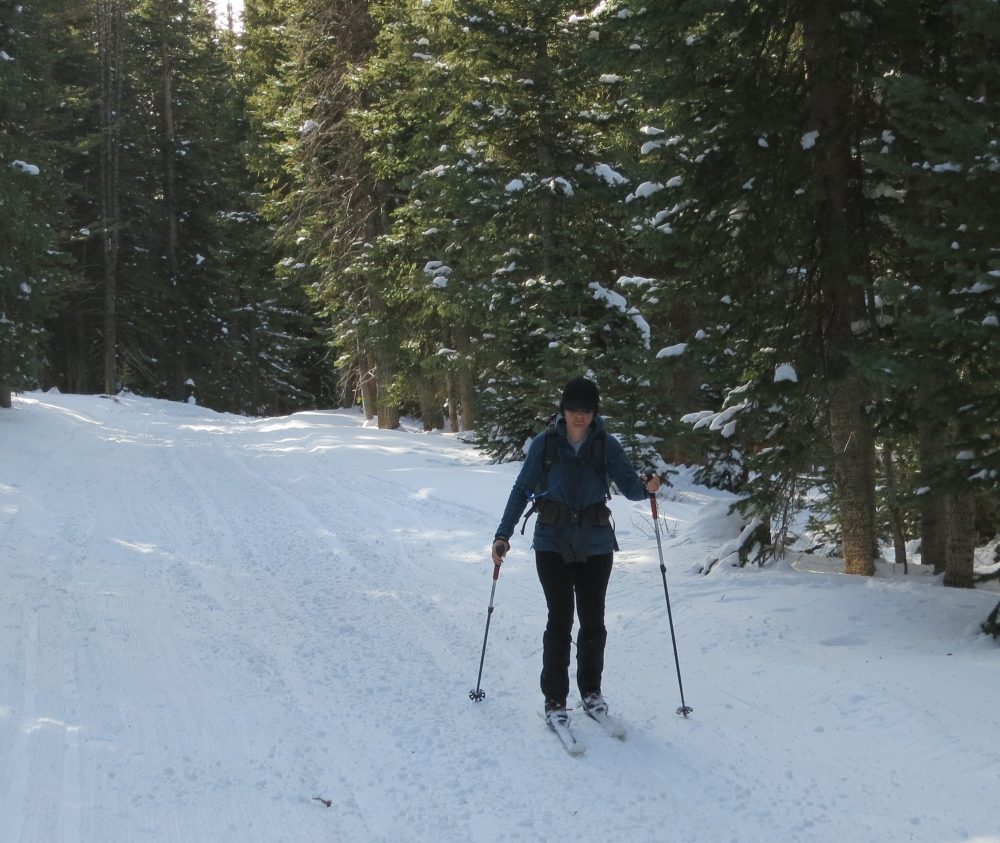Layering for comfort in outdoor wintertime activity
The key to enjoying the outdoors in wintertime is staying warm and dry. But this isn’t quite as easy as throwing on a warm, snugly coat, especially if you’re engaging in any kind of heart-pumping activity where you’re likely to build up a sweat. One minute you’re huffing and puffing up a hill on the verge of overheating, and the next you’re shivering on top of a cold windy ridge. Finding the right layering combination of clothing is essential for effective body temperature regulation while guarding against the elements.
Base Layer
The next-to-skin base layer helps regulate your body temperature by moving perspiration away from the skin to keep you dry. Depending on the temperature, level of activity, and your own sensitivity to hot and cold, choose a light, medium, or heavyweight base layer that will wick moisture away. Cotton kills in this regard, and though more expensive, I prefer merino wool because I like the natural feel, and because it doesn’t retain odor as quickly as synthetic materials. But synthetics have come a long way since the earliest incarnation of polypropylene back in the 80’s, and there are plenty of good synthetic products out there from polyester to Capilene. Silk is also an option though it is more delicate and requires special care in washing.
This is your insulating layer and usually consists of multiple items to be either put on or taken off depending on the temperature or your level of activity. While you’re moving, especially up, you’ll wear less. When you stop for a snack, or a drink of water, you’ll want to put more on. On top, my middle layer consists of a medium to heavy weight tech top or pullover, a fleece jacket, and a lightweight down puffy coat. In most cases, I’ll be moving in just the tech top, or if it’s really cold, the fleece as well. When I stop for extended periods, the puffy comes out.
I’ve also taken to wearing an extremely lightweight and breathable windbreaker, the kind road-bikers wear, over the tech top if there’s any kind of a breeze out. I’ve found this will often take the edge off just enough that I don’t have to put on the next layer of insulation, and risk overheating while I’m moving.
Bottom layering for insulation is tricky as you don’t have the same option for putting on and taking off a bunch of stuff. I wear a pair of semi-stretchy, soft shell pants that breathe well, and are wind and water resistant. These kind of bridge the gap between an insulating layer and the final shell layer and are good in most weather conditions. Then, in the bottom of my pack, I keep a pair of hard shell pants with full zips, so I can put them on over my boots in case the weather really goes south.
Shell Layer
This is your protection, the final barrier between you and the elements of wind and snow. Shells come in a variety of styles and construction from completely waterproof and non-breathable rain jackets, to waterproof and breathable hard shells, to water and wind resistant soft shells. For winter purposes, we can throw out the rain jacket, which is ultimately akin to wearing a plastic bag where you find yourself dry on the outside, and wet on the inside. A hard shell jacket made from a breathable fabric such as Gore-Tex has been the standard for skiers and mountaineers for decades, and offers the most bomb-proof protection against the forces of winter mountain weather. On the downside, hard shells are noisy, semi-bulky, and bit inflexible. Soft shells on the other hand, though not as water proof, are more breathable, more flexible, and are generally lighter weight.
I’ve come to embrace the soft shell. In the inter-mountain west, where the snow is typically dry and fluffy, soft shells offer adequate protection with increased flexibility. I also feel like I can keep it on more while I’m moving. The increased breathability helps keep me from overheating, which in the end, is what this is all about.
Hat and gloves
It goes without saying that you’ll need a hat and gloves in the winter time, but what you wear, and how you wear them can also help regulate your temperature. As a backcountry skier, I wear a light pair of gloves going up, and a heavier pair coming down. A lot of heat gets lost through your hands, so keeping your hands warm, is the key to keeping your body warm. By the same token, if you’re starting to overheat, you can take your gloves off or switch to a lighter pair before changing your clothing. Same goes for your hat. Start small. Regulate your temperature. Stay dry, and have fun out there in the winter!
Eric Trenbeath is a freelance writer and avalanche forecaster for the La Sal Mountains near Moab.






